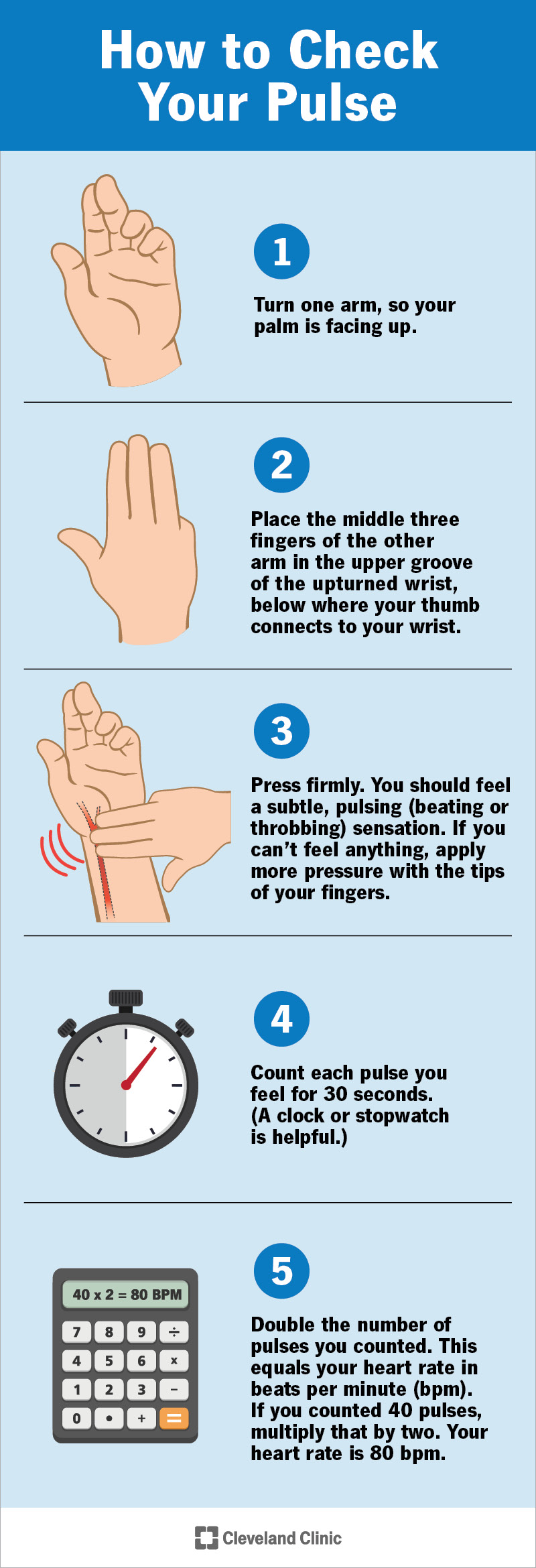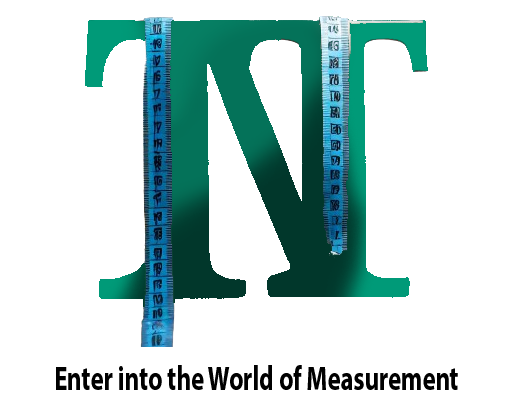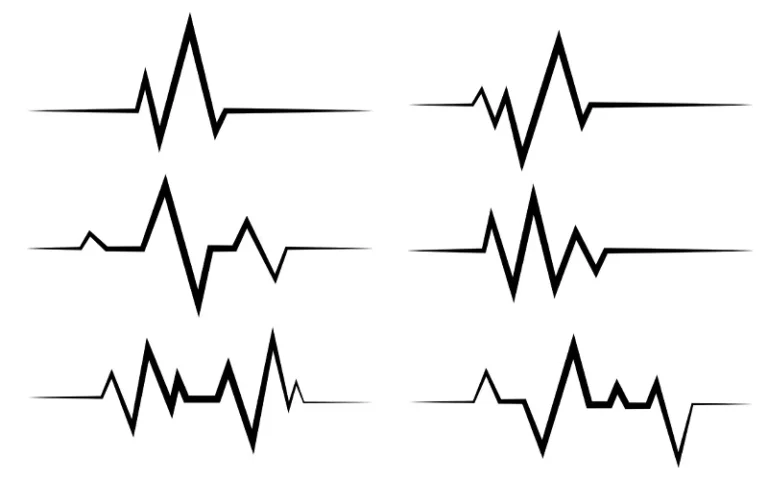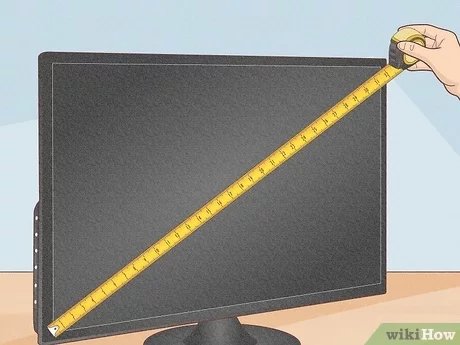How to Measure Heart Rate? Simple Steps for Accurate Tracking
To measure heart rate, place two fingers on pulse point, count beats for 15 seconds, then multiply by 4. Measuring heart rate is a simple yet crucial way to gauge cardiovascular health.
By monitoring your heart rate, you can assess your fitness levels, track intensity during exercise, and detect potential health issues. Whether using a fitness tracker, smartwatch, or manually checking your pulse, understanding how to measure heart rate accurately empowers you to take control of your well-being.
Regular monitoring of your heart rate can provide valuable insights into your overall health and help you make informed decisions to improve your fitness and quality of life.
:max_bytes(150000):strip_icc()/VWH_Illustration_How-to-Measure-Resting-Heart-Rate_Danie-Drankwalter_Final-68133f7fa9ea49b8af6d0db55f1a5cd2.jpg)
Credit: www.verywellhealth.com
Introduction To Heart Rate Monitoring
Heart rate monitoring is essential for tracking your fitness levels and overall health. To measure your heart rate, you can use various methods such as wearing a heart rate monitor, using a smartphone app, or manually checking your pulse. Monitoring your heart rate helps you gauge the intensity of your workouts and ensure you’re staying within your target heart rate zone for optimal results.
Heart rate monitoring is a simple and effective way to measure the health and fitness of an individual. It is the measurement of the number of times your heart beats per minute, and it provides important information about your cardiovascular system. Heart rate monitoring has become an essential tool for athletes, fitness enthusiasts, and medical professionals. In this blog post, we will discuss how to measure heart rate and the importance of tracking heart rate in health and fitness.
Importance Of Tracking Heart Rate
Tracking your heart rate can provide important insights into your cardiovascular health. By monitoring your heart rate, you can identify potential health issues and track your progress towards fitness goals. Here are some of the benefits of tracking heart rate:
- Helps in identifying potential heart-related issues
- Monitors the effectiveness of workouts
- Tracks progress towards fitness goals
- Helps in determining optimal exercise intensity
Applications In Health And Fitness
Heart rate monitoring is widely used in health and fitness. It helps in determining the optimal exercise intensity, which is the level of effort required to achieve your fitness goals. Here are some of the applications of heart rate monitoring in health and fitness:
| Application | Description |
| Cardiovascular disease prevention | Heart rate monitoring helps in identifying potential cardiovascular issues, enabling early intervention. |
| Weight loss | Monitoring heart rate during exercise helps in determining the optimal intensity to burn calories and lose weight. |
| Athletic performance | Heart rate monitoring helps athletes in determining their optimal training intensity and improving their performance. |
| Stress management | Monitoring heart rate can help in identifying stress levels and taking necessary steps to manage stress. |
In conclusion, heart rate monitoring is a simple and effective way to measure the health and fitness of an individual. It is important to track heart rate to identify potential health issues, monitor progress towards fitness goals, and determine optimal exercise intensity. Heart rate monitoring has several applications in health and fitness, including cardiovascular disease prevention, weight loss, athletic performance, and stress management.

Credit: my.clevelandclinic.org
Anatomy Of Heart Rate
The human heart rate, or pulse, is a vital sign that indicates the number of times a person’s heart beats per minute. Understanding the pulse and what a normal heart rate looks like is essential for monitoring one’s cardiovascular health. Let’s delve into the anatomy of heart rate and explore how it can be measured accurately.
Understanding The Pulse
The pulse is a palpable rhythmic throbbing of the arteries as blood is propelled through them by the contractions of the heart. It is commonly measured at arterial points such as the wrist, neck, and groin. The pulse rate corresponds to the heart rate and is a crucial indicator of overall cardiac function.
What A Normal Heart Rate Looks Like
A normal resting heart rate for adults ranges between 60 to 100 beats per minute. For athletes or individuals who engage in regular physical activity, a lower resting heart rate is common, often below 60 beats per minute. Newborns typically have a heart rate of 100 to 160 beats per minute, while children aged 1 to 10 years have a heart rate of 70 to 120 beats per minute.
Tools For Measuring Heart Rate
Heart rate measurement is made easy with a range of tools available. From wearable fitness trackers to smartphone apps, these devices provide accurate and convenient ways to monitor your heart rate. Stay on top of your health by easily measuring your heart rate anytime, anywhere.
When it comes to monitoring your heart rate, there are various tools available that can provide accurate measurements. From traditional methods to advancements in wearable technology, these tools offer different options for tracking your heart rate and ensuring your cardiovascular health. Let’s explore two popular ways to measure heart rate: the traditional pulse check and advancements in wearable technology.
Traditional Pulse Check
The traditional pulse check remains a reliable method to measure heart rate. This technique involves manually feeling your pulse by placing your fingers on specific locations on your body. The most common areas for checking your pulse include the wrist (radial artery) and the neck (carotid artery). By counting the number of beats within a specific time frame, usually 15 or 30 seconds, you can calculate your heart rate per minute. This method is simple, accessible, and cost-effective, making it a popular choice for many individuals.
Advancements In Wearable Technology
Wearable technology has revolutionized the way we monitor our heart rate. With the advent of smartwatches, fitness trackers, and heart rate monitors, it has become easier than ever to track and analyze heart rate data. These devices use optical sensors or electrodes to detect and measure the electrical activity of your heart. They provide real-time heart rate readings, allowing you to monitor your heart rate during physical activity, rest, and even sleep.
Moreover, advancements in wearable technology have introduced additional features such as continuous heart rate monitoring, heart rate variability analysis, and personalized heart rate zones. These tools offer valuable insights into your cardiovascular fitness, helping you optimize your workouts and improve your overall health.
In conclusion, whether you prefer the traditional pulse check or the convenience of wearable technology, measuring your heart rate is essential for understanding your cardiovascular health. By utilizing these tools, you can stay informed about your heart rate and make informed decisions regarding your well-being. So, start monitoring your heart rate today and take a proactive approach towards a healthier lifestyle.
Preparing For Heart Rate Measurement
Prepare for heart rate measurement by finding a quiet, comfortable place to sit. Rest your arm on a flat surface and place your index and middle fingers on your wrist or neck to locate your pulse. Count the beats for 30 seconds and multiply by 2 to get your heart rate in beats per minute.
Optimal Conditions For Accurate Readings
To ensure accurate heart rate measurements, it is important to create optimal conditions. By following these guidelines, you can obtain reliable results:
1. Avoid caffeine and nicotine: Consuming caffeine or nicotine can temporarily elevate heart rate, potentially affecting the accuracy of your measurements. It is recommended to abstain from these substances for at least 30 minutes before taking your heart rate.
2. Rest for at least 5 minutes: Before measuring your heart rate, take a few minutes to relax and settle into a comfortable position. This allows your heart rate to stabilize, providing a more accurate reading.
3. Find a quiet environment: Background noise and distractions can interfere with concentration, leading to inaccuracies in heart rate measurement. Choose a calm and quiet location to minimize any external influences.
4. Ensure proper positioning: Place the heart rate monitor or your fingers correctly on the pulse points. For wrist-based monitors, position the device snugly against the skin, just above the wrist bone. When using your fingers, locate the pulse either on the wrist (radial artery) or the neck (carotid artery).
5. Stay still during measurement: Movement can introduce errors in heart rate readings. Remain as still as possible while taking the measurement to obtain the most accurate result.
Factors That Can Affect Heart Rate
Several factors can influence heart rate measurements. It is important to be aware of these factors to understand any variations in readings:
1. Physical activity: Engaging in physical exercise or strenuous activities can significantly increase heart rate. It is advisable to measure your heart rate when you are at rest for the most accurate baseline reading.
2. Emotional state: Feelings of stress, anxiety, or excitement can cause fluctuations in heart rate. Try to relax and maintain a calm state of mind before measuring your heart rate.
3. Temperature: Extreme hot or cold temperatures can affect heart rate. In colder conditions, the body may increase heart rate to maintain warmth, while in hotter environments, heart rate may rise to regulate body temperature.
4. Medications: Certain medications, such as beta-blockers or stimulants, can alter heart rate. If you are taking any medications, consult with your healthcare provider to understand how they may impact your readings.
5. Age and fitness level: Heart rate can vary depending on age and fitness level. Generally, younger individuals and those who are physically fit tend to have lower resting heart rates compared to older individuals or those who are less active.
By being mindful of these factors and preparing under optimal conditions, you can ensure more accurate and reliable heart rate measurements. Remember, consistency and regular monitoring are key to understanding your heart health and making informed decisions about your well-being.
Manual Heart Rate Measurement
Manual heart rate measurement is a simple and effective way to determine your heart rate without the need for any special equipment. By finding your pulse and counting the number of beats over a specific time period, you can accurately assess your heart rate. This method is particularly useful during exercise or when you don’t have access to a heart rate monitor.
Finding Your Pulse
Finding your pulse is the first step in manually measuring your heart rate. You can locate your pulse in areas where the arteries are close to the skin’s surface, such as the wrist, neck, or the inside of the elbow. Place your index and middle fingers over the pulse point and apply gentle pressure until you feel the pulsing sensation.
Counting Heart Beats: The Step-by-step Process
- Once you’ve located your pulse, use a timer to count the number of beats for 30 seconds. Alternatively, you can count the beats for 15 seconds and multiply the total by 4 to calculate the beats per minute.
- Ensure you’re in a relaxed state and avoid moving or speaking while counting the beats to get an accurate reading.
- Record the number of beats and monitor any changes over time to track your heart rate fluctuations.
Using Technology For Heart Rate Measurement
Heart rate measurement can be done using technology such as heart rate monitors, smartwatches, and fitness trackers. These devices use sensors to detect the pulse and calculate the heart rate, providing valuable information for monitoring fitness levels and overall health.
How Smartwatches And Fitness Trackers Work
Smartwatches and fitness trackers use LED lights to detect blood volume changes.
The light reflects off blood vessels, allowing the device to calculate heart rate.
These devices provide real-time heart rate data for users’ fitness tracking needs.
Choosing The Right Device For You
Consider your fitness goals and preferred features when selecting a heart rate monitor.
- Look for a device with accurate heart rate monitoring capabilities.
- Choose a comfortable and stylish design that suits your lifestyle.
- Ensure compatibility with your smartphone for easy data synchronization.
Interpreting Your Heart Rate Data
To measure your heart rate, place two fingers on your wrist or neck and count the beats for 15 seconds. Multiply the count by 4 to get your heart rate per minute. Alternatively, use a heart rate monitor for accurate and continuous tracking.
Understanding your heart rate data can provide valuable insights into your overall health and fitness levels.
What The Numbers Mean
Your heart rate data provides crucial insights into your cardiovascular health. Understanding the numbers is essential for monitoring your overall well-being.
Actionable Insights From Your Heart Rate
By analyzing your heart rate data, you can gain valuable information on your fitness levels and exercise intensity. This data empowers you to make informed decisions about your health.
Improving Heart Health
Lifestyle Changes For A Healthier Heart
Exercise, healthy diet, stress management, and avoiding smoking.
When To Consult A Professional
If experiencing chest pain, shortness of breath, or irregular heartbeats.
Common Mistakes And Misconceptions
Measuring heart rate is a simple process that is often misunderstood. One common mistake is relying solely on the pulse in the wrist, while another misconception is that a high heart rate is always a sign of poor health. Accurate heart rate measurement requires proper technique and understanding of the body’s response to exercise.
Avoiding Inaccuracies In Heart Rate Monitoring
Ensure proper placement of the heart rate monitor for accurate readings.
Avoid wearing the monitor too loosely or too tightly.
Debunking Heart Rate Myths
Myth: Maximum heart rate is calculated by subtracting age from 220.
Fact: Individual variations exist; consult a healthcare professional for accurate assessment.

Credit: www.health.harvard.edu
The Future Of Heart Rate Tracking
Measuring heart rate is a critical aspect of personal health management. As technology continues to advance, the future of heart rate tracking is becoming increasingly promising. Emerging technologies and their potential impact on personal health management are paving the way for more convenient, accurate, and insightful heart rate tracking methods.
Emerging Technologies
The future of heart rate tracking is being shaped by cutting-edge technologies such as wearable devices, smart clothing, and advanced sensors. These innovations are enabling continuous and non-invasive monitoring of heart rate, providing individuals with real-time data to better understand their cardiovascular health.
Potential Impact On Personal Health Management
The integration of emerging heart rate tracking technologies into personal health management has the potential to revolutionize how individuals monitor and optimize their well-being. With the ability to seamlessly track heart rate throughout the day, people can gain valuable insights into their physical activity, stress levels, and overall cardiovascular health.
Frequently Asked Questions
What Is Heart Rate?
Heart rate is the number of times your heart beats per minute.
Why Is It Important To Measure Heart Rate?
Measuring heart rate helps assess heart health and intensity of physical activity.
How Can I Measure My Heart Rate?
You can measure your heart rate using a fitness tracker, smartwatch, or a heart rate monitor.
What Is The Normal Range For Heart Rate?
The normal resting heart rate for adults is 60-100 beats per minute.
When Should I Be Concerned About My Heart Rate?
Consult a healthcare professional if your heart rate is consistently outside the normal range.
Conclusion
Measuring heart rate is an essential aspect of maintaining a healthy lifestyle. Whether you’re an athlete or someone looking to improve your overall health, knowing your heart rate can help you monitor your progress and make informed decisions. With the various methods available today, measuring heart rate has become more accessible than ever before.
From wearable devices to manual measurements, finding the method that works best for you is key. Remember, taking care of your heart is essential for a long and healthy life.







